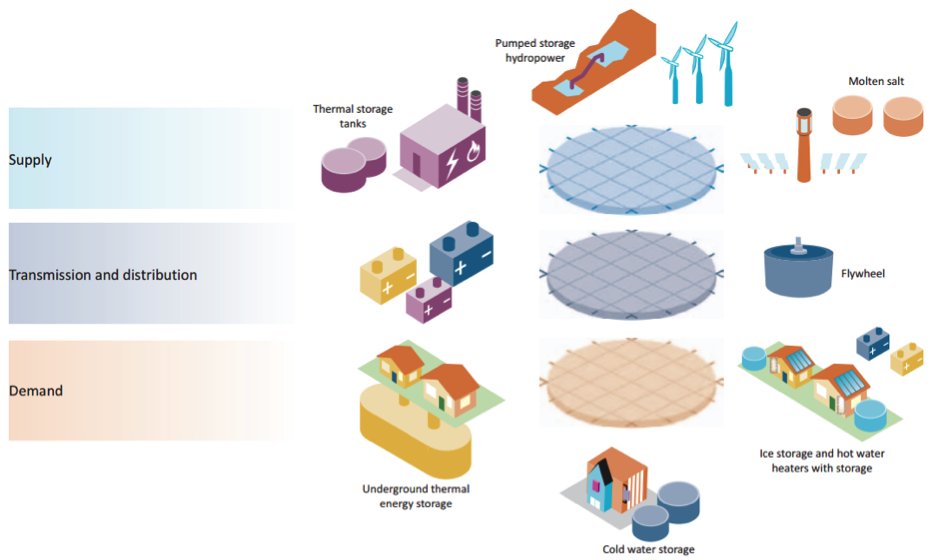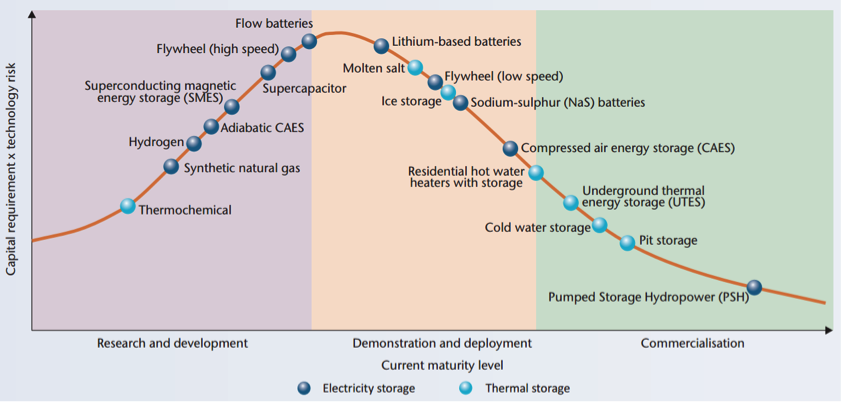The International Energy Agency has released their inaugural energy storage roadmap. A logical addition to their various renewable energy roadmaps, the report aims to project the role energy storage technologies will have in future energy markets. It highlights the value of energy storage technologies – particularly batteries – not only for resolving intermittency issues inherent to most renewable energy technologies but also as a means of increasing grid resiliency, improving arbitrage services and displacing more-expensive gas peaking plants.
A summary of relevant findings from the report is listed below.
- There many different options for energy storage, with the main options looking to store heat or electricity. Individual storage technologies often have the ability to supply multiple energy and power services. The optimal role for storage varies depending on the current energy system landscape and future developments particular to each region.
Maturity of various energy storage technologies. [Image source: IEA]
- The development of cost-effective energy storage will support renewable energy proliferation and decarbonisation.
- Smaller-scale energy storage systems are already cost competitive (or very nearly competitive) in remote community and off-grid applications.
- There is also significant potential for thermal energy storage. Thermal energy storage systems appear well-positioned to reduce the amount of heat that is currently wasted (e.g. electricity production and industrial waste heat) in the energy system. Large-scale thermal storage is already competitive for meeting heating and cooling demand in many regions.
- To support electricity sector decarbonisation such that we may keep global warming below 2°C, an estimated 310 GW of additional grid-connected electricity storage capacity would be needed in the United States, Europe, China and India.
- Market design is key to accelerating deployment. Current policy environments and market conditions do not reflect their value and are ill-equipped to compensate energy storage technologies for the suite of services that they can provide.
- Public investment in energy storage research and development has led to significant cost reductions. However, current costs remain high for many technologies and additional efforts are needed.
Energy storage costs today and for ‘breakthrough scenarios in 2050. [Image source: IEA]
As part of the report, the IEA recommends that:
- The deployment of near-term cost-effective technologies be supported;
- Marketplaces and regulatory environments are developed to enable accelerated deployment of energy storage solutions, through eliminating price distortions and allowing energy storage technologies to be compensated for providing multiple services over their lifetime; and
- R&D for early stage energy storage technologies, including high-temperature thermal storage systems, scalable battery technologies and hybrid systems, is supported.
The development of suitable energy storage solutions – batteries in particular – are crucial for our transition to low-carbon economies, with this recent IEA release echoing that sentiment. In Australia, we have shown quite strong commercial support for the energy storage industry through the rapid establishment of the Australian Energy Storage Council in 2014, placing us in good stead to capitalise on future energy storage developments.
The topic of batteries and energy storage appears much less contentious than that of renewables in general. Despite this peculiar divide in public opinion, the acceptance of energy storage solutions into our electricity grids may prove to be just as – if not more – beneficial to the solar energy industry as advancements in PV cell or module technology.
© 2015 Solar Choice Pty Ltd

